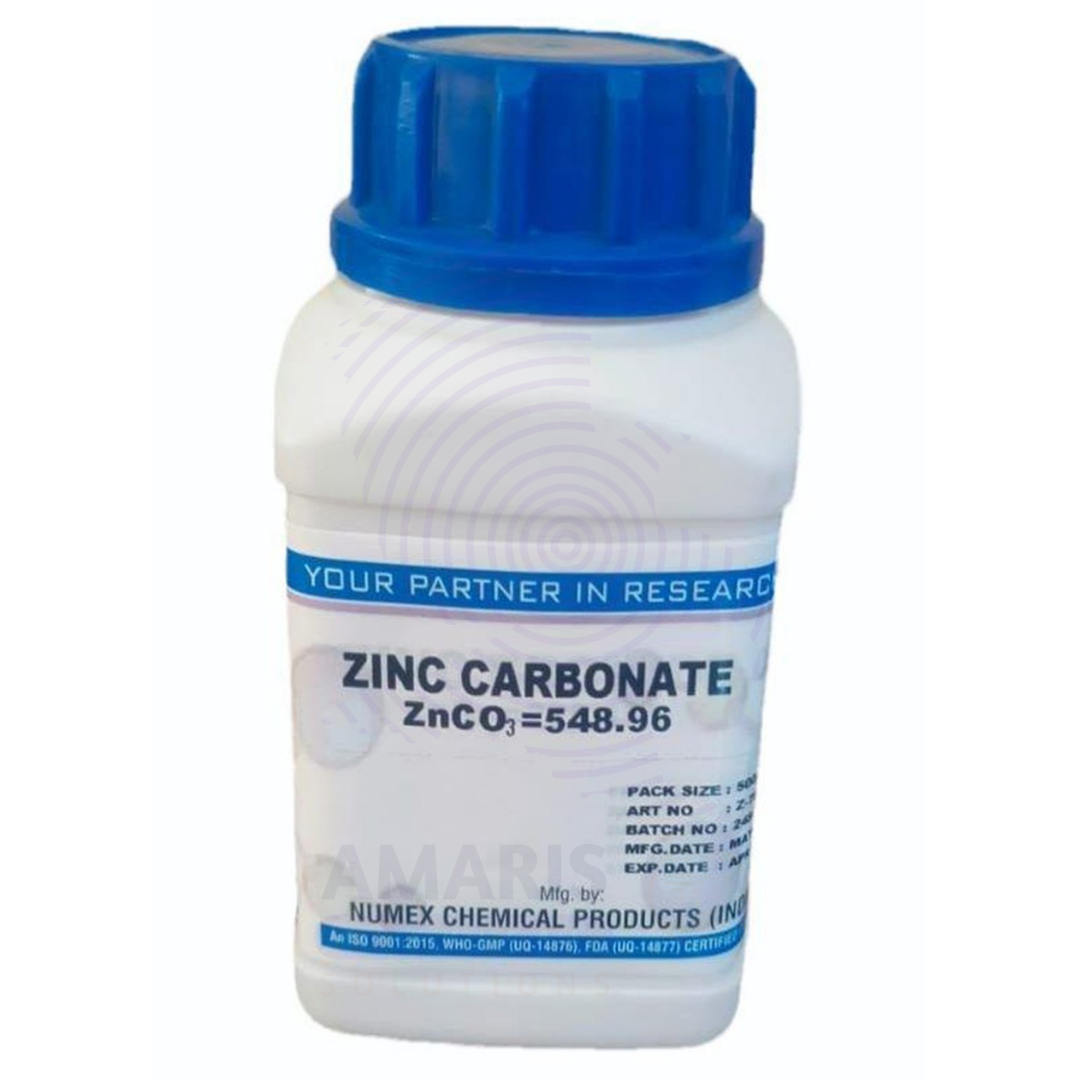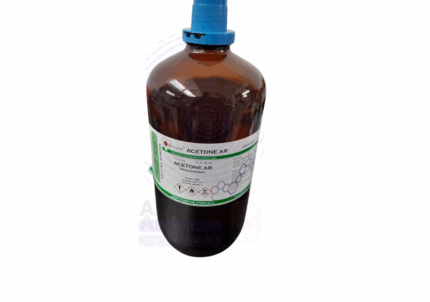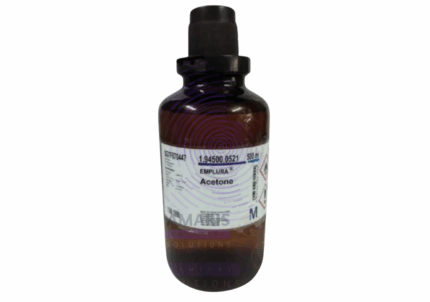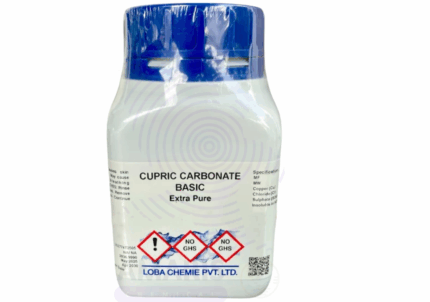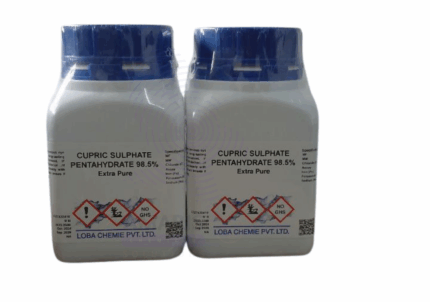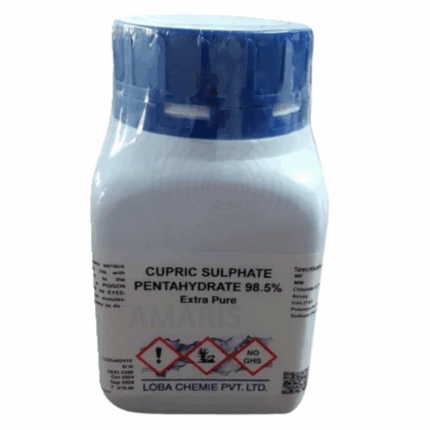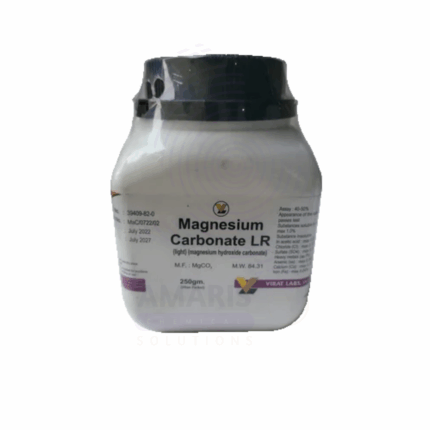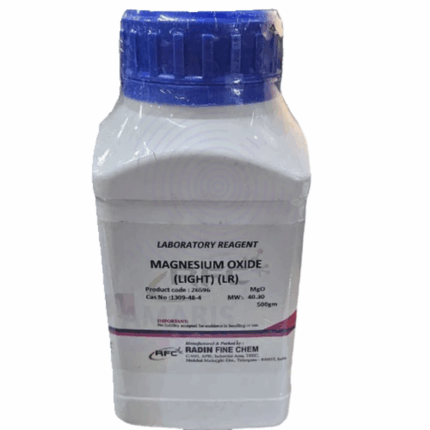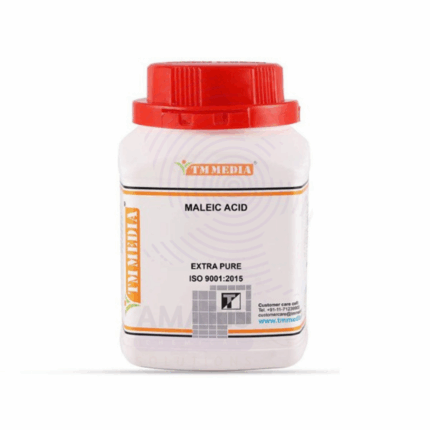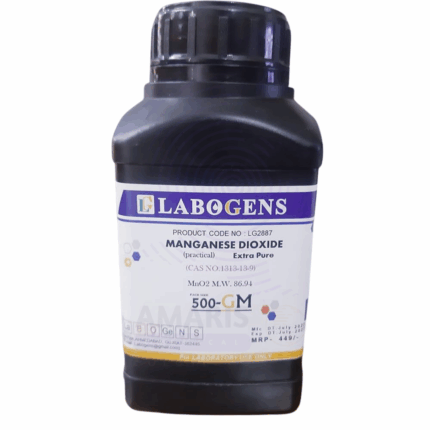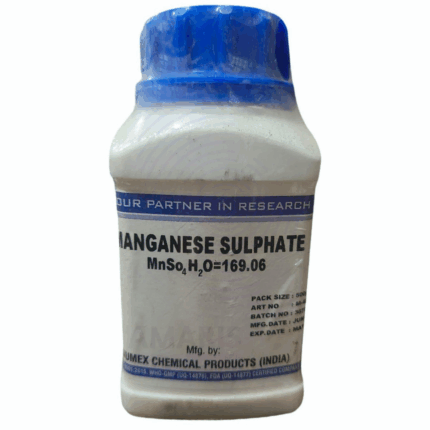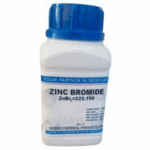
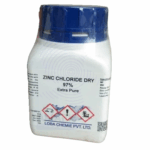
Zinc Carbonate Extra Pure
$ 15.76 Original price was: $ 15.76.$ 15.67Current price is: $ 15.67.
Zinc Carbonate Extra Pure is a high-purity white, odorless powder or granular solid with the formula ZnCO₃. It serves as an essential inorganic compound widely used in analytical laboratories, pharmaceutical, cosmetic, and agricultural industries. Its insolubility in water and decomposition at moderate heat make it useful as a precursor to zinc oxide and other zinc-based chemicals. In laboratory applications, it functions as a reagent and buffer agent, while in pharmaceutical and cosmetic fields, it is valued for its mild antiseptic and astringent properties. Environmentally, it is considered low toxicity and stable, provided it is handled correctly and kept away from acids and moisture. Proper storage and safety precautions are vital to maintain its purity and effectiveness.
Zinc Carbonate Extra Pure
PRIMARY USES
- Analytical Reagent & Laboratory Applications:
- Used as a standard reagent for quantitative analysis of zinc content
- Employed in preparation of buffer solutions and as a pH regulator in lab formulations
- Utilized in chemical synthesis involving carbonate or zinc ions
- Important in inorganic and coordination chemistry for precipitation reactions
- Used as a precursor in synthesis of zinc oxide and other zinc compounds in research
- Pharmaceutical & Cosmetic Industry:
- Used as an active ingredient in topical formulations for soothing skin conditions
- Acts as an astringent and mild antiseptic in cosmetics and personal care products
- Ingredient in powders and ointments for anti-irritant and absorbent properties
- Industrial & Chemical Manufacturing:
- Intermediate in production of zinc oxide and other zinc-based compounds
- Used in rubber and paint industries as a pigment or filler precursor
- Serves as a raw material in fertilizers and agricultural chemicals for zinc supplementation
SECONDARY USES
- Agricultural Chemicals:
- Used in micronutrient formulations to correct zinc deficiency in soils and plants
- Food Industry:
- Occasionally used as a zinc fortifier in food supplements under regulated conditions
- Environmental Applications:
- Used in some water treatment processes for removal of heavy metals and adjustment of pH
1. Basic Identification Attributes
Chemical Name: Zinc Carbonate
CAS Number: 598-62-9
HS Code: 2836.20.00
Molecular Formula: ZnCO₃
Synonyms:
- Basic zinc carbonate
- Smithsonite (natural mineral form)
- Zinc carbonate hydroxide
2. Physical & Chemical Properties
Physical State: Solid powder or granular
Color & Odor: White, odorless
Melting Point: Decomposes at ~300 °C releasing CO₂
Boiling Point: Not applicable (decomposes before boiling)
Density/Specific Gravity: ~3.3 g/cm³
Solubility:
- Insoluble in water
- Slightly soluble in acids with release of CO₂
pH Level: Neutral to slightly alkaline in suspension
Vapor Pressure & Volatility: Not volatile
Flash Point: Not flammable
Autoignition Temperature: Not applicable
Viscosity: Not applicable
3. Safety & Hazard Attributes
Hazard Class (GHS Classification):
- May cause mild skin and eye irritation (Category 3 or not classified)
NFPA Ratings: - Health: 1
- Flammability: 0
- Reactivity: 0
Exposure Limits: - No specific OSHA PEL or ACGIH TLV established
Reactivity: - Stable under normal conditions
- Reacts with acids to release carbon dioxide gas
4. Storage & Handling Attributes
Storage Conditions:
- Store in a dry, cool, well-ventilated area
- Keep container tightly closed to prevent moisture exposure
Incompatible Materials: - Strong acids (cause decomposition and CO₂ release)
- Strong oxidizing agents
Container Type: - Plastic or metal drums, tightly sealed bottles
Shelf Life & Expiration Date: - Stable for years when kept dry
Special Handling Requirements: - Use gloves and eye protection
- Avoid inhalation of dust
5. Regulatory & Compliance Attributes
Regulatory Status:
- Approved for pharmaceutical, cosmetic, and agricultural uses (where applicable)
- Listed in REACH, TSCA, and other chemical inventories
Transportation Restrictions: - Not classified as hazardous for transport
Waste Disposal Method: - Dispose according to local environmental regulations
6. Environmental & Health Impact
Ecotoxicity:
- Low toxicity to aquatic organisms
- Minimal environmental persistence
Persistence in Environment: - Slowly dissolves in acidic environments, releasing zinc ions
Carcinogenicity/Mutagenicity: - Not classified as carcinogenic or mutagenic
Biodegradability: - Inorganic; not biodegradable but environmentally benign in small quantities
SAFETY PRECAUTIONS
Personal Protective Equipment (PPE):
- Wear chemical-resistant gloves
- Use safety goggles or face shield
- Wear protective clothing
- Use dust mask if handling powder in dusty conditions
Handling:
- Avoid generating dust
- Work in a well-ventilated area
- Wash hands after handling
Storage:
- Store in sealed containers away from acids and moisture
FIRST AID MEASURES
Inhalation:
- Move to fresh air if irritation occurs
- Seek medical attention if symptoms persist
Skin Contact:
- Wash with soap and water
- Remove contaminated clothing
- Seek medical advice if irritation develops
Eye Contact:
- Rinse with plenty of water for at least 15 minutes
- Seek medical attention if irritation persists
Ingestion:
- Rinse mouth with water
- Seek medical advice if discomfort occurs
FIRE FIGHTING MEASURES
Flammability:
- Non-flammable solid
Extinguishing Media: - Use water spray, foam, dry chemical, or CO₂
Hazardous Combustion Products: - May release CO₂ on decomposition when heated strongly
Firefighter Protection: - Wear full protective gear and self-contained breathing apparatus if involved in fire


 Preservatives(food)
Preservatives(food) Flavor Enhancers
Flavor Enhancers Acidulants
Acidulants Sweeteners
Sweeteners Antioxidants
Antioxidants Colorants(food)
Colorants(food) Nutraceutical Ingredients (food)
Nutraceutical Ingredients (food) Nutrient Supplements
Nutrient Supplements Emulsifiers
Emulsifiers
 Collectors
Collectors Dust Suppressants
Dust Suppressants Explosives and Blasting Agents
Explosives and Blasting Agents Flocculants and Coagulants
Flocculants and Coagulants Frothers
Frothers Leaching Agents
Leaching Agents pH Modifiers
pH Modifiers Precious Metal Extraction Agents
Precious Metal Extraction Agents
 Antioxidants(plastic)
Antioxidants(plastic) Colorants (Pigments, Dyes)
Colorants (Pigments, Dyes) Fillers and Reinforcements
Fillers and Reinforcements Flame Retardants
Flame Retardants Monomers
Monomers Plasticizers
Plasticizers Polymerization Initiators
Polymerization Initiators Stabilizers (UV, Heat)
Stabilizers (UV, Heat)
 Antifoaming Agents
Antifoaming Agents Chelating Agents
Chelating Agents Coagulants and Flocculants
Coagulants and Flocculants Corrosion Inhibitors
Corrosion Inhibitors Disinfectants and Biocides
Disinfectants and Biocides Oxidizing Agents
Oxidizing Agents pH Adjusters
pH Adjusters Scale Inhibitors( water)
Scale Inhibitors( water)
 Antioxidants(cosmetic)
Antioxidants(cosmetic) Emollients
Emollients Fragrances and Essential Oils
Fragrances and Essential Oils Humectants
Humectants Preservatives
Preservatives Surfactants(cosmetic)
Surfactants(cosmetic) Thickeners
Thickeners UV Filters
UV Filters
 Fertilizers
Fertilizers Soil Conditioners
Soil Conditioners Plant Growth Regulators
Plant Growth Regulators Animal Feed Additives
Animal Feed Additives Biostimulants
Biostimulants Pesticides (Herbicides, Insecticides, Fungicides)
Pesticides (Herbicides, Insecticides, Fungicides)
 Active Pharmaceutical Ingredients (APIs)
Active Pharmaceutical Ingredients (APIs) Excipients
Excipients Solvents(pharmaceutical)
Solvents(pharmaceutical) Antibiotics
Antibiotics Antiseptics and Disinfectants
Antiseptics and Disinfectants Vaccine Adjuvants
Vaccine Adjuvants Nutraceutical Ingredients (pharmaceutical)
Nutraceutical Ingredients (pharmaceutical) Analgesics & Antipyretics
Analgesics & Antipyretics
 Analytical Reagents
Analytical Reagents Solvents(lab)
Solvents(lab) Chromatography Chemicals
Chromatography Chemicals Spectroscopy Reagents
Spectroscopy Reagents microbiology-and-cell-culture-reagents
microbiology-and-cell-culture-reagents Molecular Biology Reagents
Molecular Biology Reagents Biochemical Reagents
Biochemical Reagents Inorganic and Organic Standards
Inorganic and Organic Standards Laboratory Safety Chemicals
Laboratory Safety Chemicals Specialty Laboratory Chemicals(Special Laboratory Equipment)
Specialty Laboratory Chemicals(Special Laboratory Equipment)
 Demulsifiers
Demulsifiers Hydraulic Fracturing Fluids
Hydraulic Fracturing Fluids Scale Inhibitors(oil)
Scale Inhibitors(oil) Surfactants(oil)
Surfactants(oil) Drilling Fluids
Drilling Fluids
 Dyes and Pigments
Dyes and Pigments Bleaching Agents
Bleaching Agents Softening Agents
Softening Agents Finishing Agents
Finishing Agents Antistatic Agents
Antistatic Agents
 Admixtures
Admixtures Waterproofing Agents
Waterproofing Agents Sealants and Adhesives
Sealants and Adhesives Curing Compounds
Curing Compounds Concrete Repair Chemicals
Concrete Repair Chemicals Anti-Corrosion Coatings
Anti-Corrosion Coatings
 Surfactants(cleaning)
Surfactants(cleaning) Builders
Builders Enzymes
Enzymes Solvents (Cleaning)
Solvents (Cleaning) Fragrances
Fragrances
 Electronic Chemicals
Electronic Chemicals Catalysts
Catalysts Lubricants
Lubricants Photographic Chemicals
Photographic Chemicals Refrigerants
Refrigerants Automotive chemicals
Automotive chemicals Pyrotechnic Chemicals
Pyrotechnic Chemicals
 Biodegradable Surfactants
Biodegradable Surfactants Bio-based Solvents
Bio-based Solvents Renewable Polymers
Renewable Polymers Carbon Capture Chemicals
Carbon Capture Chemicals Wastewater Treatment Chemicals
Wastewater Treatment Chemicals
 Pigments
Pigments Solvents(paint)
Solvents(paint) Specialty Coatings
Specialty Coatings Binders/Resins
Binders/Resins Additives
Additives Driers
Driers Anti-Corrosion Agents
Anti-Corrosion Agents Functional Coatings
Functional Coatings Application-Specific Coatings
Application-Specific Coatings
 Fresh Herbs
Fresh Herbs Ground Spices
Ground Spices Whole Spices
Whole Spices Spice Blends
Spice Blends Dried Herbs
Dried Herbs
 Leavening Agents
Leavening Agents Dough Conditioners
Dough Conditioners Flour Treatments
Flour Treatments Fat Replacers
Fat Replacers Decoratives
Decoratives Preservatives(baking)
Preservatives(baking)
 Plasticizers & Softeners
Plasticizers & Softeners Reinforcing Agents
Reinforcing Agents Adhesion Promoters
Adhesion Promoters Vulcanizing Agents
Vulcanizing Agents Antidegradants
Antidegradants Blowing Agents
Blowing Agents Fillers & Extenders
Fillers & Extenders Accelerators & Retarders
Accelerators & Retarders